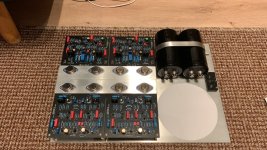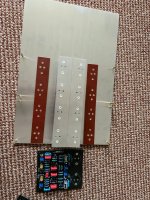I completed my build: I rebuilt the amp boards with new PCB with improved layout and went back to the original Naim regulator circuit for the power stage. The amp sounds very good and behaves better, see attached scope shots:
20kHz square wave (0.5V input) into 8R and 1uF
20kHz square wave (clipping with 3.5V input) into 8R and 1uF
20kHz square wave (0.5V input) into 8R and 1uF
20kHz square wave (clipping with 3.5V input) into 8R and 1uF
Thanks Ian! I have only a digital scope and a cheap DDS signal generator: what else can I measure with that?
Hello jpk73!
i see your new amp is very very stable on square wave it's impressive.
when I improved the stability of my old amplifier on its regulation and amplification board I also found an audible improvement especially with the improvement of the power supply board in fact.
As for objective measurements, I now have new very low distortion loudspeakers and I have done some ABX tests (so on the whole chain and not just the amplifier)
I passed the test at 0.1% distortion at 19/20 which means that the whole hi-fi system is below, a NAP250 being at 0.03% I think my version must be close to that even if I don't have a distortion meter.
https://www.audiocheck.net/blindtests_index.php
i see your new amp is very very stable on square wave it's impressive.
when I improved the stability of my old amplifier on its regulation and amplification board I also found an audible improvement especially with the improvement of the power supply board in fact.
As for objective measurements, I now have new very low distortion loudspeakers and I have done some ABX tests (so on the whole chain and not just the amplifier)
I passed the test at 0.1% distortion at 19/20 which means that the whole hi-fi system is below, a NAP250 being at 0.03% I think my version must be close to that even if I don't have a distortion meter.
https://www.audiocheck.net/blindtests_index.php
Thanks to Cristobool's courtesy, I'm also building this amplifier using the 2.3 boards. I figured that since I've benefited from my colleague's work, I should also contribute something. I have designed NCC200 boards that match the dimensions of Cristobool's boards.
Also you can find a picture of my amplifier (still under construction) 😉
Also you can find a picture of my amplifier (still under construction) 😉
Attachments
Yes, I'd already seen your thread about regulators!
There's no consensus on whether this improves quality; I've never been able to find a clear and convincing demonstration one way or the other.
So I tend to rely on my own experience and, quite simply, on what Naim Audio does.
I've since designed and built a new NAP 250 clone (with the help and work of other forum members) that I'm finally fully satisfied with. I can say that this time its design is truly accomplished and that I've corrected the mistakes I made on the previous ones.
There's no consensus on whether this improves quality; I've never been able to find a clear and convincing demonstration one way or the other.
So I tend to rely on my own experience and, quite simply, on what Naim Audio does.
I've since designed and built a new NAP 250 clone (with the help and work of other forum members) that I'm finally fully satisfied with. I can say that this time its design is truly accomplished and that I've corrected the mistakes I made on the previous ones.
Hello everyone, I just finished a new NAP 250 clone.
I had already made two other versions of the NAP 250, but as a hobbyist, I made mistakes and learned along the way how to correct them and tune this amplifier, thanks in part to other members of the diyAudio community.
My previous clone can be seen here:
So, I'll present my new version here. I can provide my files for those who wish to build one and/or conduct further tests and delve deeper into the design of a NAP250 clone.
This time...
I had already made two other versions of the NAP 250, but as a hobbyist, I made mistakes and learned along the way how to correct them and tune this amplifier, thanks in part to other members of the diyAudio community.
My previous clone can be seen here:
So, I'll present my new version here. I can provide my files for those who wish to build one and/or conduct further tests and delve deeper into the design of a NAP250 clone.
This time...
- cristobool
- Replies: 0
- Forum: Solid State
Hi, what is the benefits of power cables star point connection? is it changes frequency band, noise, distortion or what else? I would like to learn experimental results. Or you can say LF or HF is better. Music more soft or like that.
I made semi star point connection. Speakers connected to just like a star point. but, amp.'s ground or output RC filter are connected a little away from star point. I'm wandering, is it necessary to connect all the connections with star.
I made semi star point connection. Speakers connected to just like a star point. but, amp.'s ground or output RC filter are connected a little away from star point. I'm wandering, is it necessary to connect all the connections with star.
Hello mdardeniz.
I assume you're talking about the ground plane. As a hobbyist, I simply follow certain guidelines and principles in this area, but it's a much more complex and open-ended subject than it might seem at first glance.
There isn't necessarily a single best approach in all cases.
The goal of the ground plane is to achieve roughly equal potential at all points of the ground to avoid induced currents.
It's also about avoiding ground loops, particularly to avoid any noise.
In its second version of the NAP, Naim uses a hybrid ground system with star-shaped grounds plus a ground plane on the PCB, a ground plane that is not present on the input stage portion of the amplifier.
Personally, between my different clones, the differences between the routing ground planes used mainly show greater stability, even at high power, by using star planes and separating the high-current ground from the low-current ground on the main regulator.
But the issue is so complex in reality that only experimenting with different wiring can lead to the best compromise, design by design.
As for sound quality, aside from the signal-to-noise ratio, I don't think standard measurements can show any difference between an amp with a well-wired ground and one with a poorly wired ground.
However, if you perform high-power measurements on complex loads, I wouldn't be surprised if you could see big differences, and our speakers are complex loads, not simple resistors. So I think this could very well be audible in reality after all.
I assume you're talking about the ground plane. As a hobbyist, I simply follow certain guidelines and principles in this area, but it's a much more complex and open-ended subject than it might seem at first glance.
There isn't necessarily a single best approach in all cases.
The goal of the ground plane is to achieve roughly equal potential at all points of the ground to avoid induced currents.
It's also about avoiding ground loops, particularly to avoid any noise.
In its second version of the NAP, Naim uses a hybrid ground system with star-shaped grounds plus a ground plane on the PCB, a ground plane that is not present on the input stage portion of the amplifier.
Personally, between my different clones, the differences between the routing ground planes used mainly show greater stability, even at high power, by using star planes and separating the high-current ground from the low-current ground on the main regulator.
But the issue is so complex in reality that only experimenting with different wiring can lead to the best compromise, design by design.
As for sound quality, aside from the signal-to-noise ratio, I don't think standard measurements can show any difference between an amp with a well-wired ground and one with a poorly wired ground.
However, if you perform high-power measurements on complex loads, I wouldn't be surprised if you could see big differences, and our speakers are complex loads, not simple resistors. So I think this could very well be audible in reality after all.
Is it related about regulated design? it may be more important for regulated design.
Hi-end designs, I observed that some small changes makes big differences. this is not for normal design of nap140 for example. but, for original one (almost original) makes difference. For example I added 1uf film capacitor to PSU stage. the advice is add min 10uf capacitor. Made difference I don't know. But if you add many small corrections, it will makes difference.
Hi-end designs, I observed that some small changes makes big differences. this is not for normal design of nap140 for example. but, for original one (almost original) makes difference. For example I added 1uf film capacitor to PSU stage. the advice is add min 10uf capacitor. Made difference I don't know. But if you add many small corrections, it will makes difference.
The NAP 250, and especially those with dual regulation, have a more complex ground circuit, and yes, I think it's more difficult to properly wire the ground on these amps.
In my experience, when it comes to the audio quality of an amp, the devil is in the details. It's a combination of details and the quality of the components or wiring that ultimately result in a high-quality audio result.
Thinking that a good schematic and standard components are enough to achieve such a good result is a serious mistake. Every detail and component contributes to the overall picture, even if the transistors are more important than the other components.
In my experience, when it comes to the audio quality of an amp, the devil is in the details. It's a combination of details and the quality of the components or wiring that ultimately result in a high-quality audio result.
Thinking that a good schematic and standard components are enough to achieve such a good result is a serious mistake. Every detail and component contributes to the overall picture, even if the transistors are more important than the other components.
- Home
- Amplifiers
- Solid State
- NAIM NAP250 Original clone build thread
 . We don't often see any objective measurements of Naim or related high-end circuits in discussion here.
. We don't often see any objective measurements of Naim or related high-end circuits in discussion here.
